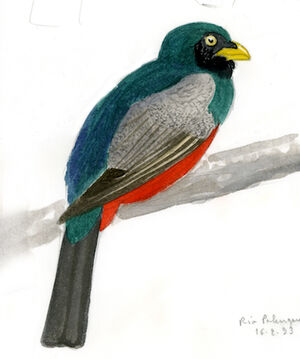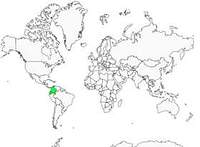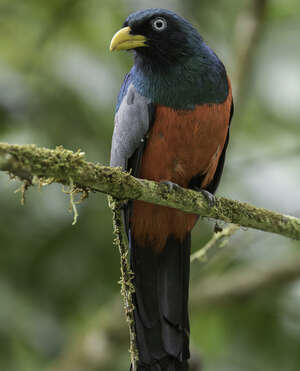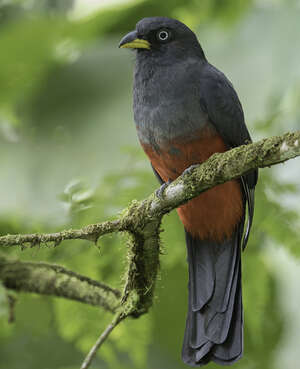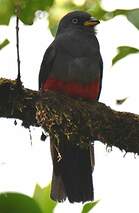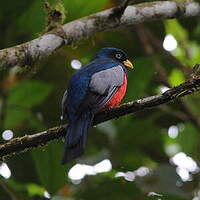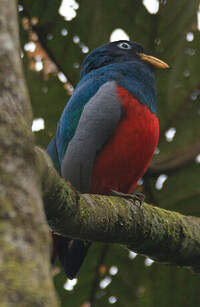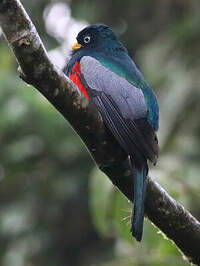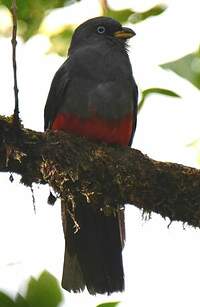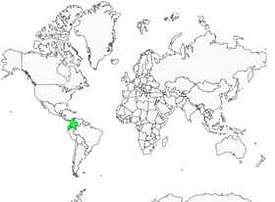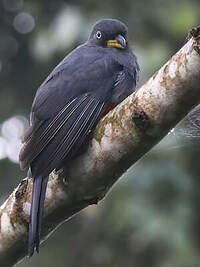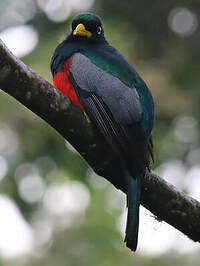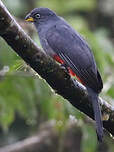Choco Trogon
Trogon comptus - Trogon aux yeux blancs
Identification
If all trogons are beautiful and colourful, only one bears a Latin name that truly describes it: Trogon comptus, meaning 'elegant and attractive'! A large trogon, 28-29 cm in length, with pronounced sexual dimorphism, probably very close to Trogon clathratus, the Band-tailed Trogon, to Trogon melanurus, the Black-tailed Trogon, and to Trogon massena, the Massena's Trogon, with whom it shares the same distribution area. The auriculars, the throat, the forehead and the upper part of the eye are black, maybe that's why Americans call it Choco Trogon; the male shows a strong yellow beak, the iris is black surrounded by a white orbital ring which is the characteristic identity of the Throat-white Trogon (a feature also present in the Band-tailed trogon). The crown, the nape, the mantle and the back are emerald green, the lower back with a hint of blue; the scapulars keep the green from the back, the coverts have very fine black and white horizontal lines that give a cloud-like stunning effect; the black wing feathers show white margins. The female is just as attractive, with shades of grey. The beak is yellow with a black-grey culmen, the eye has the same white orbital ring, the auriculars less marked than that of the male are dark grey, the crown, forehead and nape are light grey, as well as the mantle and the back; if the scapulars keep this same light grey, the coverts are rather anthracite dark grey and, remarkably, don't show any vermiculation; the black wing feathers show clear white edges.The grey chest coloring of the Choco Trogon goes lower than a male, resulting in a bright red belly. The tail has dark grey lower rectrices and light grey upper rectrices. The tarsi are brown-gray. Juveniles have rarely been observed, but may probably resembles their mothers. As bird-watching is an evolving science, renowned American ornithologist Paul Austin Jonsgard (born 28.06.1931) believes that Trogon comptus is a subspecies of Trogon clathratus, the ladder-backed trogon.
Subspecific information monotypic species
Foreign names
- Trogon aux yeux blancs,
- Trogón coliazul,
- surucuá-do-chocó,
- Blauschwanztrogon,
- fehérszemű trogon,
- Blauwstaarttrogon,
- Trogone occhibianchi,
- blåstjärtad trogon,
- Hvitøyetrogon,
- trogón bielooký,
- trogon modroocasý,
- Hvidøjet Trogon,
- valkosilmätrogoni,
- trogon del Chocó,
- trogon białooki,
- Синехвостый трогон,
- アイオキヌバネドリ,
- 白眼美洲咬鹃,
- blåstjärtad trogon,
- 藍尾美洲咬鵑〔白眼美洲咬鵑〕,
Voice song and call
Habitat
Behaviour character trait
Probably sedentary. The Choco Trogon (Trogon aux yeux blancs) is a medium-sized, perching bird between 32-33cm in size.
Dietfeeding habits
Reproduction nesting
Breeding season identified in March, observations of male singing in small groups are sometimes made, the Choco Trogon having the same attitude as many other trogons. So far, there have been no observations of this species nesting, one can only assume its behaviour, nesting in an excavation, tunnel to access a chamber?
Geographic range
Threats - protection
IUCN conservation status
concern
in the Wild
threatened
evaluated
LC wouldn't have a particular concern. In fact, its small distribution area and its habitat (humid tropical forests) protect it, without us really knowing its exact status. An old proverb says: to live happily let us live hidden, the Choco Trogon seems to have adopted this saying!
Sources of information
- IOC World Bird List (v14.2), Gill, F and D Donsker (Eds). 2024-04-18.
- A Natural history of the Trogonidae, Joseph M.Forshaw Albert Earl Gilbert
- Vol. 6 - Handbook of the Birds of the World, Josep del Hoyo-Andrew Elliott-Jordi Sargatal
- xeno-canto, Sharing bird sounds from around the world,
- Avibase, Lepage Denis
- BirdLife International, BirdLife International
- Wikipédia, Wikipedia, The Free Encyclopedia
Other sources of interest
 Specification sheet created on
04/08/2023 by Anne et Gabriel Leboff
Specification sheet created on
04/08/2023 by Anne et Gabriel LeboffTranslation by AI Oiseaux.net
© 1996-2025 Oiseaux.net
- Accipitriformes
- Aegotheliformes
- Anseriformes
- Apodiformes
- Apterygiformes
- Bucerotiformes
- Caprimulgiformes
- Cariamiformes
- Casuariiformes
- Charadriiformes
- Ciconiiformes
- Coliiformes
- Columbiformes
- Coraciiformes
- Cuculiformes
- Eurypygiformes
- Falconiformes
- Galliformes
- Gaviiformes
- Gruiformes
- Leptosomiformes
- Mesitornithiformes
- Musophagiformes
- Nyctibiiformes
- Opisthocomiformes
- Otidiformes
- Passeriformes
- Pelecaniformes
- Phaethontiformes
- Phoenicopteriformes
- Piciformes
- Podargiformes
- Podicipediformes
- Procellariiformes
- Psittaciformes
- Pterocliformes
- Rheiformes
- Sphenisciformes
- Steatornithiformes
- Strigiformes
- Struthioniformes
- Suliformes
- Tinamiformes
- Trogoniformes

